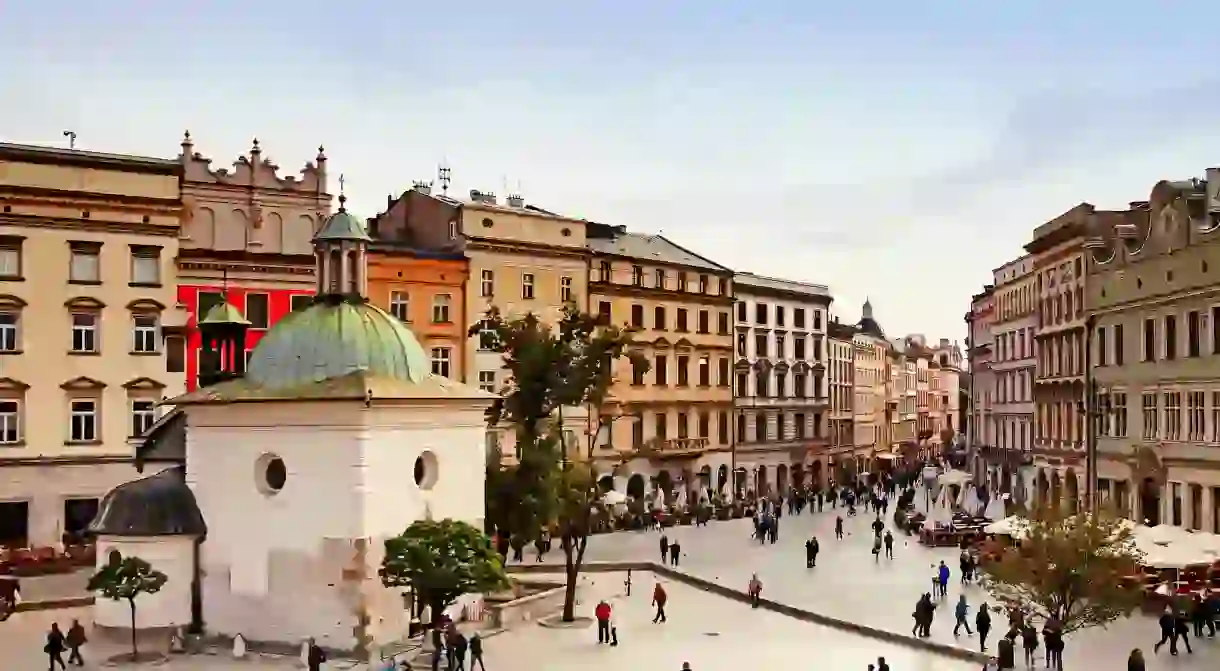An Architecture Lover's Guide to Krakow

Krakow holds everything from Gothic spires to great medieval castles to explore, making for a city that’s rich in magnificent architectural feats and lived-in districts alike. While Warsaw is known for playing host to perhaps one of the most ambitious reconstruction projects in post-war Europe, Krakow is famed for scraping through the dark days of the 20th century relatively unscathed. That’s not to say that the town didn’t suffer the same tumultuous past as its capital neighbour to the north – it did. However, Krakow was not the site of the same destructive battles, and while art and cultural treasures were looted by the train load, the great Gothic and medieval monuments, the Renaissance palaces and beautiful Baroque churches were largely left standing.
Architecture in the Krakow Old Town
Because Krakow was built from the centre out, starting with the Neolithic settlements on the Wawel Hill, it’s still relatively easy to trace the evolution of the town’s architecture. Make for the Old Town area (a UNESCO World Heritage Site in its own right) to see the oldest relics. On the north end of Florianska Street there’s the crumbling remnants of the historic city walls, fronted by the mighty Barbikan (dating from 1499), the onetime defender of the Florian Gate. In fact, this is the only remaining section of the old fortifications, which were totally replaced in the 19th century by the green-belt Planty Park.

Those who walk the cobbles of Florianska Street southwards will be following the historic Royal Road. This iconic procession route of the Polish kings goes right through the heart of the Old Town and all the way to the famous Wawel Castle, and it hosts some of the city’s most iconic architectural treasures along the way.
Most notable of these is the Main Market Square, which sprawls out right in the heart of the city, complete with a grand Renaissance Cloth Hall (built in the 1400s) where traders from all across Europe would once have touted silk and salt, and the iconic twin redbrick spires of St. Mary’s Basilica. The latter is arguably the most important church in Poland, representing a masterful rendition of the late Gothic design and hosting an enchanting interior altarpiece by Viet Stoss. It’s also worth checking out the pretty little Church of St. Adalbert, which is one of the few remaining examples of the Polish Romanesque style in Krakow, and the oldest Christian chapel in the city to boot.

From the Main Square, be sure to follow Grodzka Street southwards (the Royal Road route). This bustling thoroughfare might be laden with bars and kebab restaurants now, but it was once peppered with important merchant guilds and regal mansions. Take a right and you’ll soon come to the Gothic manor of Collegium Maius, which is where Nicolaus Copernicus once worked in the richly adorned interior rooms. Keep going south and it’s the Saints Peter and Paul Church that comes into view. This is perhaps the first ever Baroque-style construction ever raised in Poland, built by Italian architects in the 1500s, and finished with a romantic interior by Giovanni Battista Trevano.

Architecture around the Wawel Hill
As you reach the end of Grodzka Street, the single most elaborate and iconic piece in Krakow comes into view: the Wawel Castle. This mighty fortress was once the epicentre of the medieval town, and today is a veritable palimpsest of all the great construction styles to imbue the city over the centuries.

Venture in and you’ll be able to tour everything from the Upper Castle’s Gothic residences, built in the 1300s, and the later Renaissance arcades, which look plucked straight from the romantic towns of central Italy, and bear the scars of a destructive fire in 1595. It’s also atop the Wawel Hill that you’ll find the shimmering gold domes of the Wawel Cathedral. This awesome patchwork of architecture fuses the Romanesque, the Renaissance and the Baroque with old medievalism, and hosts some of the country’s most totemic tombs.
Architecture in Kazimierz and Podgorze
To the south of the Old Town area is where you’ll find the more lived-in architecture of the Kazimierz and Podgorze districts. While still dating all the way back to the 11th century, these areas have a distinct style to them. Kazimierz, for one, was officially designated as a Jewish settlement from the 13th century onwards, which meant that synagogues took the place of monumental churches. Perhaps the best of these – the Old Synagogue – can still be seen, having survived near destruction at the hands of the Nazis, on the edge of Szeroka Street.

Architecture in Nowa Huta
For an altogether different side of Krakow’s curious medley of architectural styles, visitors should be sure to ride the rattling city trams out to the district of Nowa Huta. This whole neighbourhood was purpose-built by the Russians in the 1950s. It was planned to be the perfect utilitarian and communist settlement, complete with self-contained housing blocks and industrial steelworks. Everything still stands, from the Stalinist sprawl of the tenements to the wide boulevards, some even complete with ageing tanks on the pavements!














